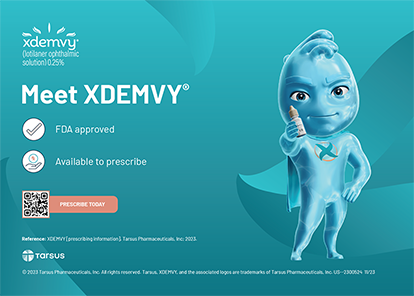
Before my cataract surgery, I had -3.00 D of myopia in both eyes, and I had been a lifelong contact lens–wearer. I hated spectacles because I couldn’t access the slit lamp while wearing them. When I started to become presbyopic, I used over-the-counter readers, which were okay, but I eventually switched to monovision with contact lenses and loved it. I thought monovision was the greatest thing ever, and I decided that, whenever I developed cataracts, monovision with IOLs would be my top choice.
Over the years, I needed more and more correction in my nondominant eye as my presbyopia worsened, and I began to feel that monovision was compromising my distance vision too much. As this happened, I flipped my opinion completely and decided that IOL monovision was, in fact, not for me. I was convinced that there would be no satisfactory way for me to handle it when my cataracts developed because I would have to leave myself too myopic in my nondominant eye.
At that point, I started wearing multifocal contact lenses in both eyes. Again, I thought this was a great option at first, but then I realized it was compromising my distance vision. I eventually ended up wearing a distance contact lens in my dominant right eye and a multifocal contact lens in my left eye. I loved that, and I had been doing that for years when I began to develop a cataract in my right eye.
making choices: Lenses and Laser
I realized that I was developing that cataract when I began noticing a bit of blurring and glare in that eye. I was afraid that it would affect my ability to perform surgery, so I decided to have a monofocal IOL implanted. After surgery in my right eye, I wore a multifocal contact lens in my left eye. At night, when I took the multifocal contact lens out, it was the same experience I had in the past with contact lens monovision. That would not have been satisfactory day to day, but I could deal with it at night.
About 6 to 12 months later, when the cataract in my left eye began to develop, I decided to have a multifocal IOL implanted in that eye.
I ended up choosing a Tecnis Multifocal IOL ZLB00 (Johnson & Johnson Vision), which has a fairly strong add power, +3.25 D. I didn’t want to go with a multifocal with a lower add power or with an extended depth of focus lens because I was concerned about being able to see very fine detail. I was not so concerned about being able to see well in the intermediate range.
Choosing that IOL was one of the hardest aspects of my entire cataract experience. I consulted about 50 ophthalmologist friends of mine and discussed all the combinations they would offer if they were operating on me. (Of course, no surgeon agreed with any other.)
I wanted to have laser cataract surgery because I wanted the precision of the femtosecond laser. I use a femtosecond laser for my patients, particularly in an eye that is going to have a multifocal IOL implanted.
William F. Wiley, MD, who is a good friend of mine, performed the cataract surgeries on both of my eyes, and both times he used a femtosecond laser. He also placed limbal relaxing incisions to correct the small amount of astigmatism in each eye.
day of surgery
Dr. Wiley uses sublingual sedation with midazolam, ketamine, and ondansetron (MKO Melt, ImprimisRx), which eliminates the need for intravenous sedation. I thought it was amazing. It took only about 10 to 15 minutes to kick in, and when it did I went into the OR feeling like a zombie. I was able to hold still, I didn’t feel anything or pay attention to anything, and surgery was over within what seemed like just a few minutes.
When I got back to the recovery room, I was ready to go, went to lunch later that day and felt fine.
What has Changed
Several things have changed about the way I practice since I’ve had my cataract surgeries. The first is that it is easy for me to tell a patient, “Hey, I had cataract surgery, and it is not so scary.” I tell patients that I had surgery on a Thursday and was back in the OR operating the next Monday. I also speak to patients about why I chose to have laser cataract surgery.
My direct experience with the surgery for which many of my patients see me provides reassurance for many of them. I can tell patients I’ve had the full spectrum: I had laser treatment, astigmatism correction, and a monofocal IOL in my right eye, and laser treatment, astigmatism correction, and a multifocal IOL in my left eye.
Customized vision
My cataract experience reinforces to me something that many surgeons are doing now: mixing and matching IOLs for what we call customized vision. I have patients who want to have good distance and near vision. I don’t select the IOLs for a patient’s two eyes at the same time now. I prefer to wait until the first eye is done so I can see how the patient is tolerating his or her IOL before selecting the IOL for the second eye. I can create a kind of mix-and-match eye care. Some patients may want a high-add multifocal in one eye and a low-add multifocal in the other. Others may want a monofocal IOL in one eye and a multifocal in the other. My experience has opened my eyes to the possibility of these combinations, and I am comfortable with the concept.
talking to patients
I talk openly with patients about the aberrations that I get with my multifocal IOL. I can see the rings in the multifocal IOL, but the starbursts that I see in the multifocal eye are no worse than those in the monofocal eye. The only difference is that I see three little rings, almost like a bullseye, within the starburst in the multifocal eye. It’s also only when I really look for it that I can see it. If I look at a headlight at night, I can see the rings, but they don’t bother me because I am expecting it.
I say to patients, “Expect to see these things. When you see the rings and starbursts, you know the lens is working. If you choose a multifocal lens, you’ve got to live with the trade-off. If you’re not willing to live with it, don’t choose that lens because we don’t want to have to take it out.”
MOST VALUABLE part
Being able to reassure patients pre- and postoperatively has been the most valuable part of my whole experience with cataracts. If a patient comes to me describing halos or starbursts, I can say, “Oh, I saw the same thing,” or, “Here’s how mine looked after surgery.”
I recall now that on day 1 postoperative I had all kinds of crazy aberrations because my pupil was still dilated. I tell patients exactly what they will most likely experience, and it reassures them. This insight has proven invaluable.




